All Publications
Generation of Pseudo Metabolites as a Side Reaction in On-Tissue Chemical Derivatization in Matrix-Assisted Laser Desorption/Ionization Mass Spectrometry Imaging
T. Bausbacher, A.L. Henneberg, S. Meyer, S. Schmidt, A.K. Miller,* C.A. Opitz,* C. Hopf* Chem. Methods 2025, e202500090. (* equal contribution)
__________________________________________________________________________________________________________________
Site-specific activation of the proton pump inhibitor rabeprazole by tetrathiolate zinc centers
T. Marker, R.R. Steimbach, C. Perez-Borrajero, M. Luzarowski, E. Hartmann, S. Schliech, D. Pastor-Flores, E. Espinet, A. Trumpp, A.A. Teleman, F. Gräter, B. Simon, A.K. Miller*, T.P. Dick* Nat. Chem. 2025, 17, 507–517. (* co-corresponding authors)
Highlighted in a “News and Views” summary.
__________________________________________________________________________________________________________________

TR-FRET assay for profiling HDAC10 inhibitors and PROTACs
K. Remans, P. Sehr, R.R. Steimbach, N. Gunkel, A.K. Miller Methods Enzymol. 2025, 715, 41–63.
__________________________________________________________________________________________________________________
Differential KEAP1/NRF2 mediated signaling widens the therapeutic window of redox-targeting drugs in SCLC therapy
J. Samarin, H. Nůsková, P. Fabrowski, M. Malz, E. Amtmann, M.J. Taeubert, D. Pastor-Flores, D. Kazdal, R. Kurilov, N. de Vries, H. Pink, F. Deis, J. Hummel-Eisenbeiss, K. Kaushal, T.P. Dick, G. Hamilton, M. Muckenthaler, M. Mall, B. Lim, T. Kanamaru, G. Klinke, M. Sos, J. Frede, A.K. Miller, H. Alborzinia, N. Gunkel. BioRxiv, 2024.
__________________________________________________________________________________________________________________
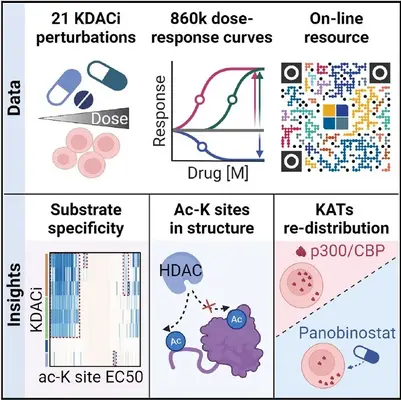
Decrypting lysine deacetylase inhibitor action and protein modifications by dose-resolved proteomics
Y.-C. Chang, C. Gnann, R.R. Steimbach, F.P. Bayer, S. Lechner, A. Sakhteman, M. Abele, J. Zecha, J. Trendel, M. The, E. Lundberg, A.K. Miller, B. Kuster Cell Rep. 2024, 43, 114272.
__________________________________________________________________________________________________________________
Multimechanism biological profiling of tetrahydro-β-carboline analogues as selective HDAC6 inhibitors for the treatment of Alzheimer's disease
T. Liang, S. Liu, B. Dang, X. Luan, Y. Guo, R.R. Steimbach, A.K. Miller, J. Hu, L. Lu, P. Yue, R. Wang, M. Zheng, J. Gao, X. Yin, X. Chen Eur. J. Med. Chem. 2024, 275, 116624.
__________________________________________________________________________________________________________________
Competition for cysteine acylation by C16:0 and C18:0 derived lipids is a global phenomenon in the proteome
H. Nůsková, F. Garcia-Cortizo, L.S. Schwenker, T. Sachsenheimer, E. Diakonov, M. Tiebe, M. Schneider, J. Lohbeck, C. Reid, A. Kopp-Schneider, D. Helm, B. Brügger, A.K. Miller, A. A. Teleman J. Biol. Chem. 2023, 299, 105088.
__________________________________________________________________________________________________________________
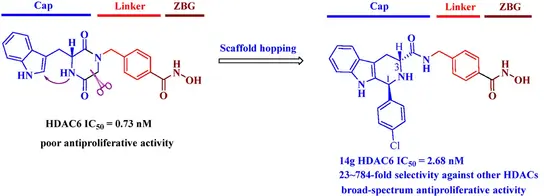
Tetrahydro-β-carboline derivatives as potent histone deacetylase 6 inhibitors with broad-spectrum antiproliferative activity
X. Chen, J. Wang, P. Zhao, B. Dang, T. Liang, R.R. Steimbach, A.K. Miller, J. Liu, X. Wang, T. Zhang, X. Luan, J. Hu, J. Gao Eur. J. Med. Chem. 2023, 260, 115776.
__________________________________________________________________________________________________________________
Chemoproteomic target deconvolution reveals histone deacetylases as targets of (R)-lipoic acid
S. Lechner, R.R. Steimbach, L. Wang, M.L. Deline, Y.-C. Chang, T. Fromme, M. Klingenspor, P. Matthias, A.K. Miller, G. Medard, B. Kuster Nat. Comm. 2023, 14, 3548.
__________________________________________________________________________________________________________________
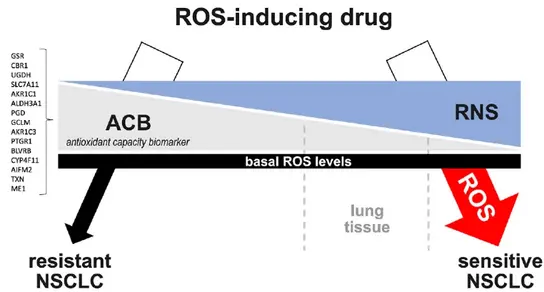
Low level of antioxidant capacity biomarkers but not target overexpression predicts vulnerability to ROS-inducing drugs
J. Samarin, P. Fabrowski, R. Kurilov, H. Nuskova, J. Hummel-Eisenbeiss, H. Pink, N. Li, V. Weru, H. Alborzinia, U. Yildiz, L. Grob, M. Taubert, M. Czech, M. Morgen, C. Brandstädter, K. Becker, L. Mao, A.K. Jayavelu, A. Goncalves, U. Uhrig, J. Seiler, Y. Lyu, S. Diederichs, U. Klingmüller, M. Muckenthaler, A. Kopp-Schneider, A. Teleman, A.K. Miller, N. Gunkel Redox Biol. 2023, 62, 102639.
__________________________________________________________________________________________________________________
Important Requirements for Desorption/Ionization Mass Spectrometric Measurements of Temozolomide-Induced 2′-Deoxyguanosine Methylations in DNA
M. Fresnais, I. Jung, U.B. Klein, A.K. Miller, S. Turcan, W. E. Haefeli, J. Burhenne and R. Longuespée Cancers 2023, 15, 716.
__________________________________________________________________________________________________________________
A trypanosome-derived immunotherapeutics platform elicits potent high-affinity antibodies, negating the effects of the synthetic opioid fentanyl
G. Triller, E.P. Vlachou, H. Hashemi, M. van Straaten, J. Zeelen, Y. Kelemen, C. Baehr, C.L. Marker, S. Ruf, A. Svirina, S. Kruse, A. Baumann, A.K. Miller, M. Bartel, M. Pravetoni, C.E. Stebbins, F.N. Papavasiliou, J.P. Verdi Cell Rep. 2023, 42, 112049.
__________________________________________________________________________________________________________________

Hydropersulfides inhibit lipid peroxidation and ferroptosis by scavenging radicals
U. Barayeu, D. Schilling, M. Eid, T. N. X. da Silva, L. Schlicker, N. Mitreska, C. Zapp, F. Gräter, A. K. Miller, R. Kappl, A. Schulze, J. P. F. Angeli, T. P. Dick Nat. Chem. Biol. 2023, 19, 28–37.
__________________________________________________________________________________________________________________

A KLK6 activity-based probe reveals a role for KLK6 activity in pancreatic cancer cell invasion
L. Zhang, S. Lovell, E. De Vita, P.K.A. Jagtap. L. Daniel, G. Goya, S, Kjaer, A. Borg, J. Hennig, A.K. Miller, E.W. Tate J. Am. Chem. Soc. 2022, 144, 22493–22504.
__________________________________________________________________________________________________________________
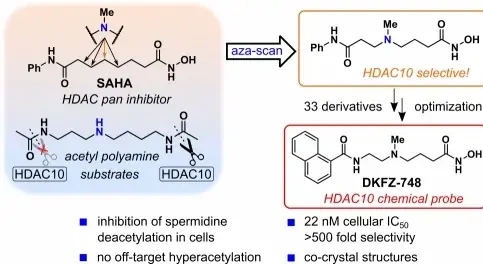
Aza-SAHA Derivatives are Selective Histone Deacetylase 10 Chemical Probes That Inhibit Polyamine Deacetylation and Phenocopy HDAC10 Knockout
R.R. Steimbach, C.J. Herbst-Gervasoni, S. Lechner, T.M. Stewart, G. Klinke, J. Ridinger, M.N.E. Geraldy, G. Tihanyi, J.R. Foley, U. Uhrig, B. Küster, G. Poschet, R.A. Casero Jr., G. Medard, I. Oehme, D.W. Christianson, N. Gunkel, A.K. Miller J. Am. Chem. Soc. 2022, 144, 18861–18875.
__________________________________________________________________________________________________________________
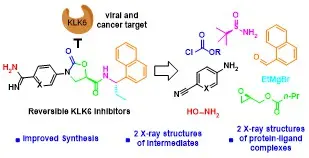
Scalable synthesis and structural characterization of reversible KLK6 inhibitors (Correction)
A. Baumann, D. Isak, J. Lohbeck, P.K.A. Jagtap, J. Hennig, A. K. Miller RSC Advances 2022, 12, 26989–26993.
__________________________________________________________________________________________________________________
Histone deacetylase 10 liberates spermidine to support polyamine homeostasis and tumor cell growth
T. M. Stewart, J. R. Foley, C. E. Holbert, G. Klinke, G. Poschet, R. R. Steimbach, A. K. Miller , R. A. Casero Jr J. Biol. Chem. 2022, 298, 102407.
__________________________________________________________________________________________________________________
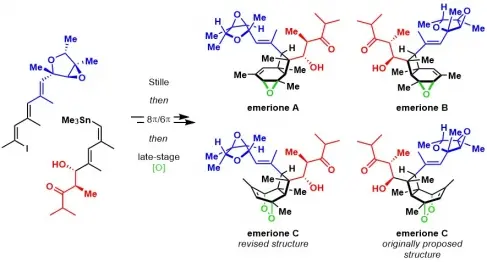
Bioinspired Asymmetric Total Synthesis of Emeriones A–C
S. Jänner*, D. Isak*, Y. Li, K.N. Houk, A.K. Miller Ang. Chem. Int. Ed. 2022, 61, e202205878. (* equal contribution)
__________________________________________________________________________________________________________________
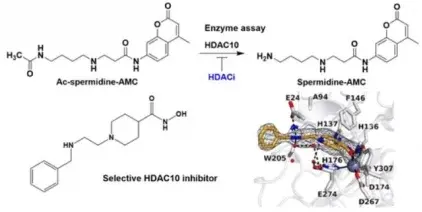
First Fluorescent Acetylspermidine Deacetylation Assay for HDAC10 Identifies Selective Inhibitors with Cellular Target Engagement
D. Herp, J. Ridinger, D. Robaa, S. A. Shinsky, K. Schmidtkunz, T. Z. Yesiloglu, T. Bayer, R.R. Steimbach, C.J. Herbst-Gervasoni, A. Merz, C. Romier, P. Sehr, N. Gunkel, A. K. Miller, D. W. Christianson, I. Oehme, W. Sippl, M. Jung ChemBioChem 2022, 23, e202200180.
__________________________________________________________________________________________________________________

Commonly Used Alkylating Agents Limit Persulfide Detection by Converting Protein Persulfides into Thioethers
D. Schilling, U. Barayeu, R.R. Steimbach, D. Talwar, A.K. Miller, T. Dick Ang. Chem. Int. Ed. 2022, 61, e202203684.
__________________________________________________________________________________________________________________
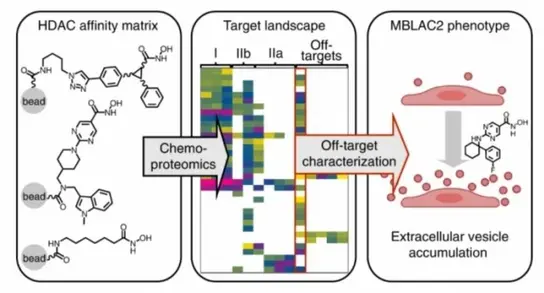
Target deconvolution of HDAC pharmacopoeia reveals MBLAC2 as common off-target
S. Lechner, M.I.P. Malgapo, C. Grätz, R.R. Steimbach...A.K.Miller, M.W. Pfaffl, M.E. Linder, B. Kuster, G. Medard Nat. Chem. Biol. 2022, 18, 812–820.
__________________________________________________________________________________________________________________
Real-world evidence for preventive effects of statins on cancer incidence: A trans-Atlantic analysis
B.-O Gohlke, F. Zincke, A. Eckert, D. Kobelt, S. Preissner, J.M. Liebeskind, N. Gunkel, K. Putzker, J. Lewis, S. Preissner, B. Kortüm, W. Walther, C. Mura, P.E. Bourne, U. Stein, R. Preissner Clin. Transl. Med. 2022, 12, e726.
__________________________________________________________________________________________________________________
Consitutional PIGA mutations cause a novel subtype of hemochromatosis in patients with neurologic dysfunction
L. Muckenthaler, O. Marques, S. Colucci, J. Kunz, P. Fabrowski, T. Bast, S. Altamura, B. Höchsmann, H. Schrezenmeier, M. Langlotz, P. Richter-Pechanska, T. Rausch, N. Hofmeister-Mielke, N. Gunkel, M.W. Hentze, A.E. Kulozik, M.U. Muckenthaler Blood 2022, 139, 1418–1422.
__________________________________________________________________________________________________________________
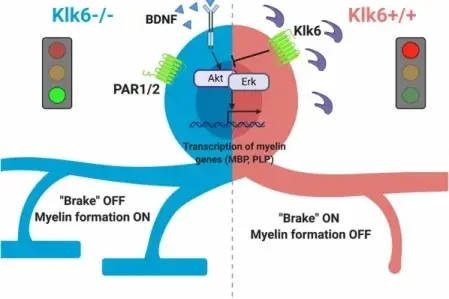
Blocking Kallikrein 6 promotes developmental myelination
H.Yoon, E.M. Triplet, W.L. Simon, C.-I. Choi, L.S. Kleppe, E. De Vita, A.K. Miller, I.A. Scarisbrick Glia 2022, 70, 430–450.
__________________________________________________________________________________________________________________

Can an Intermediate Rate of Nitrogen Inversion Affect Drug Efficacy?
R.R. Steimbach, G. Tihanyi, M. Géraldy, A. Wzorek, A.K. Miller, K.D. Klika Symmetry 2021, 13, 1753.
__________________________________________________________________________________________________________________
Evaluating Invasive Marbled Crayfish as a Potential Livestock for Sustainable Aquaculture
S. Tönges, K. Masagounder, F. Lenich, J. Gutekunst, M. Tönges, J. Lohbeck, A.K.Miller, F. Böhl, F. Lyko Front. Ecol. Evol. 2021, 9, 651981.
__________________________________________________________________________________________________________________
Stearic acid blunts growth-factor signaling via oleoylation of GNAI proteins
H. Nůsková, M.V. Serebryakova, A. Ferrer-Caelles, T. Sachsenheimer, C. Lüchtenborg, A.K. Miller, B. Bruegger, L.V. Kordyukova, A.A. Teleman Nat. Comm. 2021, 12, 4590.
__________________________________________________________________________________________________________________

Inclusion Complexes of Gold(I)-Dithiocarbamates with β-Cyclodextrin: A Journey from Drug Repurposing towards Drug Discovery
M. Morgen, P. Fabrowki, E. Amtmann, N. Gunkel, A.K. Miller Chem. Eur. J. 2021, 27, 12156–12165.
__________________________________________________________________________________________________________________

Preparation of 1-Benzyl-7-methylene-1,5,6,7-tetrahydro-4H-benzo[d]imidazol-4-one
M. Morgen, J. Lohbeck, A. K. Miller OrgSyn 2021, 98, 315–342.
__________________________________________________________________________________________________________________
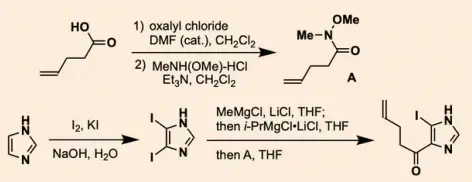
Mild mono-Acylation of 4,5-Diiodoimidazole: Preparation of 1-(5-Iodo-1H-imidazole-4-yl)pent-4-en-1-one
M. Morgen, J. Lohbeck, A. K. Miller OrgSyn 2021, 98, 171–193.
__________________________________________________________________________________________________________________

Structural Basis for the Selective Inhibition of HDAC10, the Cytosolic Polyamine Deacetylase
C. J. Herbst-Gervasoni, R. R. Steimbach, M. Morgen, A. K. Miller, D. W. Christianson ACS Chem. Biol. 2020, 15, 2154–2163.
__________________________________________________________________________________________________________________
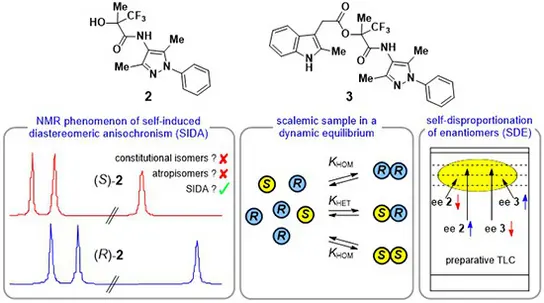
Potentially Mistaking Enantiomers for Different Compounds Due to the Self-Induced Diastereomeric Anisochronism (SIDA) Phenomenon
A. Baumann, A. Wzorek, V. A. Soloshonok, K. D. Klika, A. K. Miller Symmetry 2020, 12, 1106.
__________________________________________________________________________________________________________________

Design and Synthesis of Dihydroxamic Acids as HDAC6/8/10 Inhibitors
M. Morgen, R. R. Steimbach, M. Géraldy, L. Hellweg, P. Sehr, J. Ridinger, O. Witt , I. Oehme, C. J. Herbst‐Gervasoni, J. D. Osko, N. J. Porter, D. W. Christianson, N. Gunkel, A. K. Miller ChemMedChem 2020, 15, 1163–1174.
__________________________________________________________________________________________________________________

Novel 2, 5-Diketopiperazine Derivatives as Potent Selective Histone Deacetylase 6 Inhibitors: Rational Design, Synthesis and Antiproliferative Activity
X. Chen, X. Chen, R.R. Steimbach, T. Wu, H. Li, W. Dan, P. Shi, C. Cao, D. Li, A.K. Miller, J. Gao, Y. Zhu Eur. J. Med. Chem. 2020, 187, 111950.
__________________________________________________________________________________________________________________

Synthesis and Structure–Activity Relationships of N-(4-Benzamidino)-Oxazolidinones–Potent and Selective Inhibitors of Kallikrein-Related Peptidase 6
E. De Vita, N. Smits, H. van den Hurk, E.M. Beck, J. Hewitt, G. Baillie, E. Russell, A. Pannifer, V. Hamon, A. Morrison, S.P. McElroy, P. Jones, N.A. Ignatenko, N. Gunkel, A.K. Miller ChemMedChem 2020, 15, 79–95.
__________________________________________________________________________________________________________________
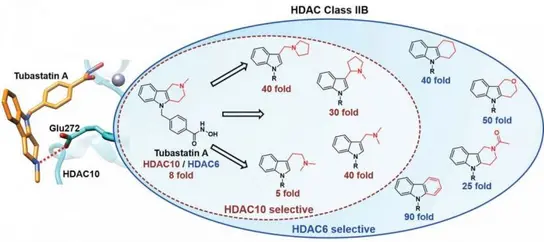
Selective Inhibition of Histone Deacetylase 10: Hydrogen Bonding to the Gatekeeper Residue is Implicated
M. Geraldy, M. Morgen, P. Sehr, R.R. Steimbach, J. Ridinger, I. Oehme, O. Witt, M. Malz, M.S. Nogueira, O. Koch, N. Gunkel, A.K. Miller J. Med. Chem. 2019, 62, 4426–4443.
__________________________________________________________________________________________________________________
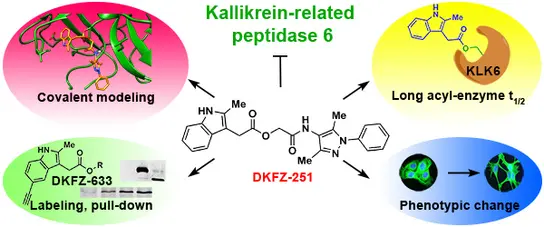
Depsipeptides featuring a neutral P1 are potent inhibitors of kallikrein-related peptidase 6 with on-target cellular activity
E. De Vita, P. Schüler, S. Lovell, J. Lohbeck, S. Kullmann, E. Rabinovich, A. Sananes, B. Heßling, V. Hamon, N. Papo, J. Heß, E.W. Tate, N. Gunkel, A.K. Miller J. Med. Chem. 2018, 61, 8859–8874.
__________________________________________________________________________________________________________________
The HDAC6/8/10 inhibitor TH34 indu ces DNA damage-mediated cell death in human high-grade neuroblastoma cell lines
F.R. Kolbinger, E. Koeneke, J. Ridinger, T. Heimburg, T. Bayer, W. Sippl, M. Jung, N. Gunkel, A.K. Miller, O. Witt, I. Oehme Archives of Toxicology 2018, 92, 2649–2664.
__________________________________________________________________________________________________________________
Dual role of HDAC10 in lysosomal exocytosis and DNA repair promotes neuroblastoma chemoresistance
J. Ridinger, E. Koeneke, F.R. Kolbinger, K. Koerholz, S. Mahboobi, N. Gunkel, A.K. Miller, H. Peterziel, A. Hamacher-Brady, O. Witt, I. Oehme Sci. Rep. 2018, 8, 10039.
__________________________________________________________________________________________________________________
A potent, proteolysis-resistant inhibitor of kallikrein-related peptidase 6 (KLK6) for cancer therapy, developed by combinatorial engineering
A. Sananes, I. Cohen, A. Shahar, A. Hockla, E. De Vita, A.K. Miller, E. Radisky, N. Papo J. Biol. Chem. 2018, 293, 12663–12680.
__________________________________________________________________________________________________________________
Rapid detection of 2-hydroxyglutarate in frozen sections of IDH mutant tumors by MALDI-TOF mass spectrometry
R. Longuespée, A.K. Wefers, E. De Vita, A.K. Miller, D.E. Reuss, W. Wick, C. Herold-Mende, M. Kriegsmann, P. Schirmacher, A. von Deimling, S. Pusch Acta Neuropathol. Commun. 2018, 6, 21.
__________________________________________________________________________________________________________________
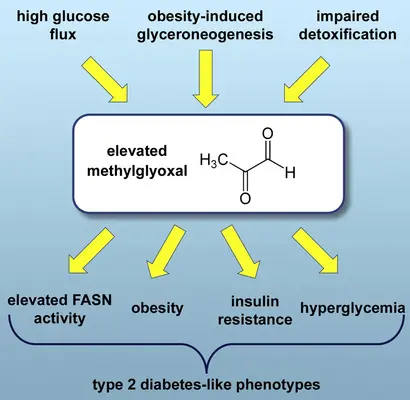
Elevated Levels of the Reactive Metabolite Methylglyoxal Recapitulate Progression of Type 2 Diabetes
A. Moraru, J. Wiederstein, D. Pfaff, T. Fleming, A.K. Miller, P. Nawroth, A.A. Teleman Cell Metab. 2018, 27, 926–934.
__________________________________________________________________________________________________________________
Parametric modeling and optimal experimental designs for estimating isobolograms for drug interactions in toxicology
T. Holland-Letz, N. Gunkel, E. Amtmann, A. Kopp-Schneider J. Biopharm. Stat. 2018, 28, 763–777.
__________________________________________________________________________________________________________________
Drug Innovation in Academia: A Helmholtz Drug Research Initiative Conference
A.K. Miller, M. Brönstrup ChemMedChem 2017, 12, 1652–1654.
__________________________________________________________________________________________________________________

Practical synthesis of a phthalimide-based Cereblon ligand to enable PROTAC development
J. Lohbeck, A.K. Miller Bioorg. Med. Chem. Lett. 2016, 26, 5260–5262.
__________________________________________________________________________________________________________________
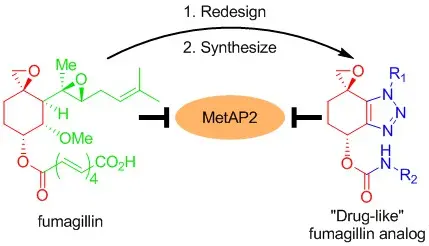
Spiroepoxytriazoles Are Fumagillin-like Irreversible Inhibitors of MetAP2 with Potent Cellular Activity
M. Morgen, C. Jöst, M. Malz, R. Janowski, D. Niessing, C.D. Klein, N. Gunkel, A.K. Miller ACS Chem. Biol. 2016, 11, 1001–1011.
__________________________________________________________________________________________________________________
Impaired aldehyde dehydrogenase 1 subfamily member 2A-dependent retinoic acid signaling is related with a mesenchymal-like phenotype and an unfavorable prognosis of head and neck squamous cell carcinoma
K. Seidensaal, A. Nollert, A.H. Feige, M. Muller, T. Fleming, N. Gunkel, K. Zaoui, N.Grabe, W. Weichert, K.J. Weber, P. Plinkert, C. Simon, J. Hess Mol Cancer 2015, 14, 204.
__________________________________________________________________________________________________________________
Regulation of mitochondrial morphology and function by stearoylation of TFR1
D. Senyilmaz, S. Virtue, X. Xu, C.Y. Tan, J.L. Griffin, A.K. Miller, A. Vidal-Puig, A.A. Teleman Nature 2015, 525, 124–128.
__________________________________________________________________________________________________________________
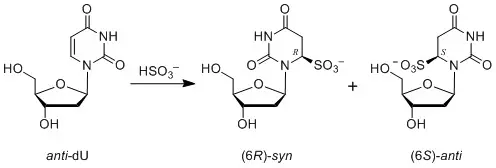
The C6 configuration and syn/anti conformational preference of the bisulfite adducts of deoxyuridine and deoxycytidine by NMR and DFT calculations
K.D. Klika, P. Schüler, A.K. Miller Tetrahedron Asymmetry 2014, 25, 1335–1339.
__________________________________________________________________________________________________________________
D-2-Hydroxyglutarate producing neo-enzymatic activity inversely correlates with frequency of the type of isocitrate dehydrogenase 1 mutations found in glioma
S. Pusch, L. Schweizer, A.C. Beck, J.M. Lehmler, S. Weissert, J. Balss, A.K. Miller, A. von Deimling Acta Neuropathol. Commun. 2014, 2, 19.
__________________________________________________________________________________________________________________
Sequencing the sixth base (5-hydroxymethylcytosine): selective DNA oxidation enables base-pair resolution
P. Schüler, A.K. Miller Angew. Chem. Int. Ed. 2012, 51, 10704.
__________________________________________________________________________________________________________________
Catalysis in the Total Synthesis of Bryostatin 16
A.K. Miller Angew. Chem. Int. Ed. 2009, 48, 3221–3223.
Supervised Publications
Total Synthesis of (–)-Heptemerone B and (–)-Guanacastepene E
A.K. Miller, C.C. Hughes, J.J. Kennedy-Smith, S.N. Gradl, D. Trauner J. Am. Chem. Soc. 2006, 128, 17057-17062.
Mapping the Chemistry of Highly Unsaturated Pyrone Polyketides
A.K. Miller, D. Trauner Synlett 2006, 14, 2295–2316.
An Electrochemical Approach to the Guanacastepenes
C.C. Hughes, A.K. Miller, D. Trauner Org. Lett. 2005, 7, 3425–3428.
Biomimetic Synthesis of Elysiapyrones A and B
J. Barbarow, A.K. Miller, D. Trauner Org. Lett. 2005, 7, 2901–2903.
Stereoselective Synthesis of Cyercene A and the Placidenes
G. Liang, A.K. Miller, D. Trauner Org. Lett. 2005, 7, 819–821.
The Total Synthesis of (–)-Crispatene
A.K. Miller, D. Byun, C. Beaudry, D. Trauner Proc. Nat. Acad. Sci. 2004, 101, 12019–12023.
Development of Novel Lewis Acid Catalyzed Cycloisomerizations: Synthesis of Bicyclo[3.1.0]hexenes and Cyclopentenones
A.K. Miller, M.R. Banghart, C. Beaudry, J.M. Suh, D. Trauner Tetrahedron, 2003, 59, 8919–8930.
Total Synthesis of (±)-Photodeoxytridachione Using a Lewis Acid Catalyzed Cyclization
A.K. Miller, D. Trauner Ang. Chem. Int. Ed. 2003, 42, 549–552.
Synthesis of Arylpiperazines via Palladium Catalyzed Aromatic Amination Reactions with Unprotected Piperazines
S.-H. Zhao, A.K. Miller, J. Berger, L.A. Flippin Tetrahedron Lett. 1996, 37, 4463–4466.